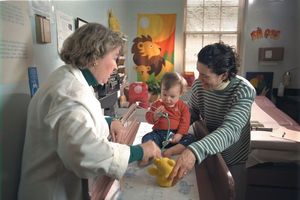United Way works for a Healthier America
 Whether it is a neighbor without health insurance, a victim of abuse, or someone struggling with mental illness or an addiction, United Ways are working to ensure everyone has access to affordable and quality care.
Whether it is a neighbor without health insurance, a victim of abuse, or someone struggling with mental illness or an addiction, United Ways are working to ensure everyone has access to affordable and quality care.
Our Goal
United Way of Lapeer County is working to reduce the incidence of chronic disease through elinmination of the barriers to comprehensive health services, reducing risky behaviors and promoting healthy life choices. By the year 2020 we hope to increase by one-third the number of youth and adults in our community who are healthy.
Our Strategy
Through partnernships with employers, governement and nonprofits, United Way is working to:
►Reduce barriers to health care access
►Stabilize families and individuals in immediate crisis
►Increase physical activitiy and healthy eating behaviors
Our Partners
- Child Advocacy Center With funding provided by United Way of Lapeer County the Child Advocacy Center is providing a prevention program called "Don't Just Talk About It-Do Something About It". This program is designed to decrease dating violence among teens and increase prevention.
- LACADA Lapeer Area Citizens Against Deomestic Assault is the domestic violence and sexual assault emergency shelter and outreach program for Lapeer County. With funding provided by United Way of Lapeer County they are providing a domestic violence prevention program.
- Loving Hands Clinic Providing non-emergency medical care at no-charge to uninsured or underinsured adults between the ages of 19-64 who financially qualify and live in Lapeer County.
- American Red Cross Lapeer County Chapter United Way of Lapeer County supports American Red Cross's medical transportation called Med-A-Ride for residents in Lapeer County who would be unable to attend medical appointments due to lack of transportation.
Health Facts
- More than 33% of children and adolescents are overweight or obese. That’s 25 million kids and teenagers.
- Children with health coverage are better prepared to learn in school and succeed in life.1
- The number of Americans without health insurance has increased steadily since the beginning of the century, now totaling about 47 million. More than 80% are working families.2
- 8.7 million children live without health insurance – more than the total number enrolled in the first and second grades in U.S. public schools.3
1Institute of Medicine. From Neurons to Neighborhood: The Science of Early Childhood Development. Washington DC: National Academies Press, 2000.)
2Employee Benefit Research Institute estimates from the March Current Population Survey, 2007 Supplement.
3Compiled by the State Health Access Data Assistance Center (SHADAC), University of Minnesota School of Public Health, using data from the U.S. Census Bureau’s Current Population Survey 2007.
